Environmental Science Assignment: Great Pacific Garbage Patch Analysis
VerifiedAdded on 2022/11/23
|7
|1589
|148
Homework Assignment
AI Summary
This assignment analyzes an article about the Great Pacific Garbage Patch, a massive accumulation of marine debris in the North Pacific Ocean, primarily composed of plastic. The assignment identifies and justifies the sustainability theme, highlighting the dangers of plastic pollution, its non-degradable nature, and its impact on aquatic life and the overall ecosystem. The analysis connects the article to various aspects of sustainability, including the extinction of marine life, the impact on coastal environments, and the potential for human extinction due to water scarcity and environmental degradation. It also connects the article to the Four Ways of Thinking (Futures, Values, Systems, Strategic), emphasizing the need for immediate action. The assignment concludes by reiterating the warning provided by nature about the impending environmental crisis due to plastic accumulation. The student has utilized the course content, videos and assignments to support their arguments.
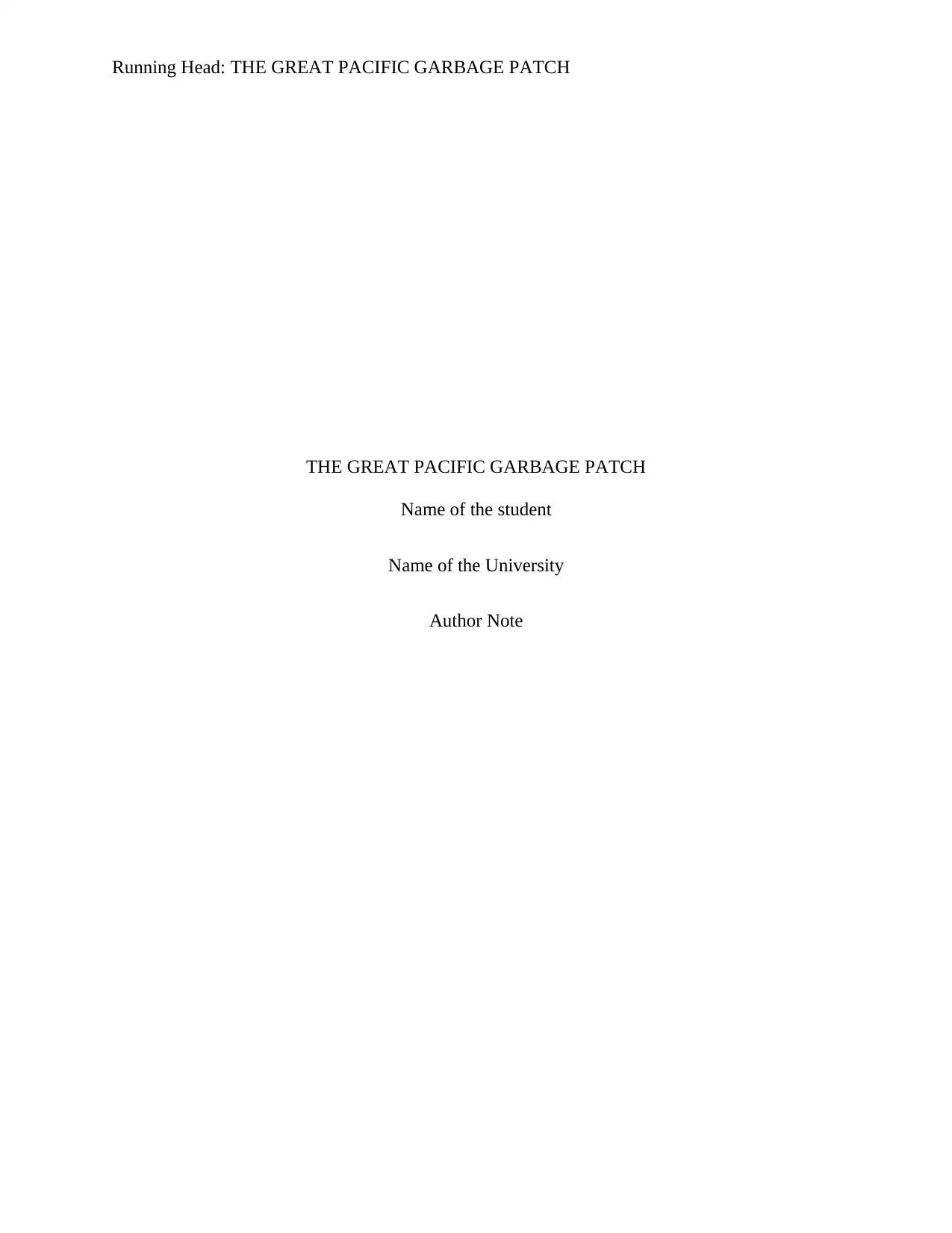
Running Head: THE GREAT PACIFIC GARBAGE PATCH
THE GREAT PACIFIC GARBAGE PATCH
Name of the student
Name of the University
Author Note
THE GREAT PACIFIC GARBAGE PATCH
Name of the student
Name of the University
Author Note
Paraphrase This Document
Need a fresh take? Get an instant paraphrase of this document with our AI Paraphraser
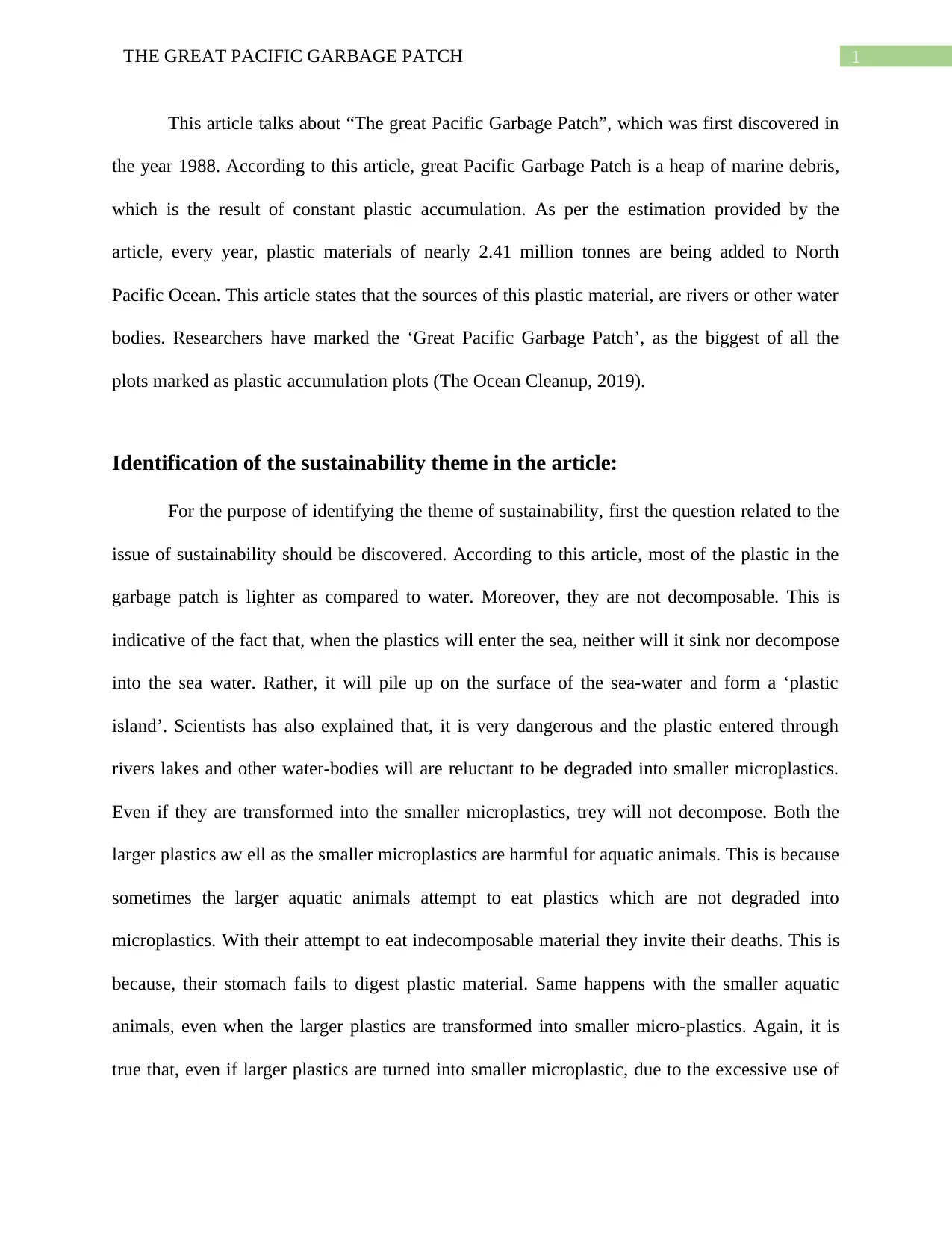
1THE GREAT PACIFIC GARBAGE PATCH
This article talks about “The great Pacific Garbage Patch”, which was first discovered in
the year 1988. According to this article, great Pacific Garbage Patch is a heap of marine debris,
which is the result of constant plastic accumulation. As per the estimation provided by the
article, every year, plastic materials of nearly 2.41 million tonnes are being added to North
Pacific Ocean. This article states that the sources of this plastic material, are rivers or other water
bodies. Researchers have marked the ‘Great Pacific Garbage Patch’, as the biggest of all the
plots marked as plastic accumulation plots (The Ocean Cleanup, 2019).
Identification of the sustainability theme in the article:
For the purpose of identifying the theme of sustainability, first the question related to the
issue of sustainability should be discovered. According to this article, most of the plastic in the
garbage patch is lighter as compared to water. Moreover, they are not decomposable. This is
indicative of the fact that, when the plastics will enter the sea, neither will it sink nor decompose
into the sea water. Rather, it will pile up on the surface of the sea-water and form a ‘plastic
island’. Scientists has also explained that, it is very dangerous and the plastic entered through
rivers lakes and other water-bodies will are reluctant to be degraded into smaller microplastics.
Even if they are transformed into the smaller microplastics, trey will not decompose. Both the
larger plastics aw ell as the smaller microplastics are harmful for aquatic animals. This is because
sometimes the larger aquatic animals attempt to eat plastics which are not degraded into
microplastics. With their attempt to eat indecomposable material they invite their deaths. This is
because, their stomach fails to digest plastic material. Same happens with the smaller aquatic
animals, even when the larger plastics are transformed into smaller micro-plastics. Again, it is
true that, even if larger plastics are turned into smaller microplastic, due to the excessive use of
This article talks about “The great Pacific Garbage Patch”, which was first discovered in
the year 1988. According to this article, great Pacific Garbage Patch is a heap of marine debris,
which is the result of constant plastic accumulation. As per the estimation provided by the
article, every year, plastic materials of nearly 2.41 million tonnes are being added to North
Pacific Ocean. This article states that the sources of this plastic material, are rivers or other water
bodies. Researchers have marked the ‘Great Pacific Garbage Patch’, as the biggest of all the
plots marked as plastic accumulation plots (The Ocean Cleanup, 2019).
Identification of the sustainability theme in the article:
For the purpose of identifying the theme of sustainability, first the question related to the
issue of sustainability should be discovered. According to this article, most of the plastic in the
garbage patch is lighter as compared to water. Moreover, they are not decomposable. This is
indicative of the fact that, when the plastics will enter the sea, neither will it sink nor decompose
into the sea water. Rather, it will pile up on the surface of the sea-water and form a ‘plastic
island’. Scientists has also explained that, it is very dangerous and the plastic entered through
rivers lakes and other water-bodies will are reluctant to be degraded into smaller microplastics.
Even if they are transformed into the smaller microplastics, trey will not decompose. Both the
larger plastics aw ell as the smaller microplastics are harmful for aquatic animals. This is because
sometimes the larger aquatic animals attempt to eat plastics which are not degraded into
microplastics. With their attempt to eat indecomposable material they invite their deaths. This is
because, their stomach fails to digest plastic material. Same happens with the smaller aquatic
animals, even when the larger plastics are transformed into smaller micro-plastics. Again, it is
true that, even if larger plastics are turned into smaller microplastic, due to the excessive use of
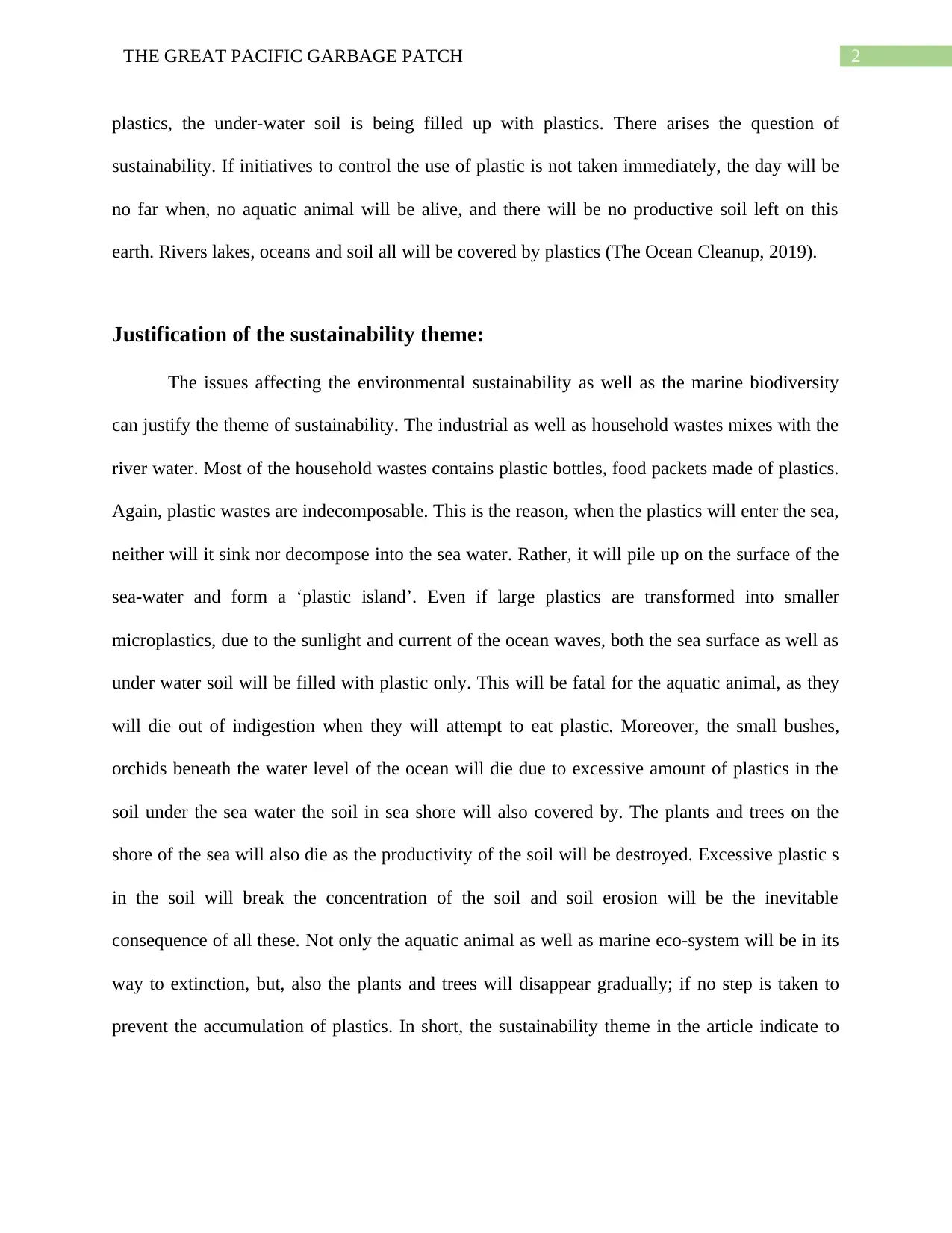
2THE GREAT PACIFIC GARBAGE PATCH
plastics, the under-water soil is being filled up with plastics. There arises the question of
sustainability. If initiatives to control the use of plastic is not taken immediately, the day will be
no far when, no aquatic animal will be alive, and there will be no productive soil left on this
earth. Rivers lakes, oceans and soil all will be covered by plastics (The Ocean Cleanup, 2019).
Justification of the sustainability theme:
The issues affecting the environmental sustainability as well as the marine biodiversity
can justify the theme of sustainability. The industrial as well as household wastes mixes with the
river water. Most of the household wastes contains plastic bottles, food packets made of plastics.
Again, plastic wastes are indecomposable. This is the reason, when the plastics will enter the sea,
neither will it sink nor decompose into the sea water. Rather, it will pile up on the surface of the
sea-water and form a ‘plastic island’. Even if large plastics are transformed into smaller
microplastics, due to the sunlight and current of the ocean waves, both the sea surface as well as
under water soil will be filled with plastic only. This will be fatal for the aquatic animal, as they
will die out of indigestion when they will attempt to eat plastic. Moreover, the small bushes,
orchids beneath the water level of the ocean will die due to excessive amount of plastics in the
soil under the sea water the soil in sea shore will also covered by. The plants and trees on the
shore of the sea will also die as the productivity of the soil will be destroyed. Excessive plastic s
in the soil will break the concentration of the soil and soil erosion will be the inevitable
consequence of all these. Not only the aquatic animal as well as marine eco-system will be in its
way to extinction, but, also the plants and trees will disappear gradually; if no step is taken to
prevent the accumulation of plastics. In short, the sustainability theme in the article indicate to
plastics, the under-water soil is being filled up with plastics. There arises the question of
sustainability. If initiatives to control the use of plastic is not taken immediately, the day will be
no far when, no aquatic animal will be alive, and there will be no productive soil left on this
earth. Rivers lakes, oceans and soil all will be covered by plastics (The Ocean Cleanup, 2019).
Justification of the sustainability theme:
The issues affecting the environmental sustainability as well as the marine biodiversity
can justify the theme of sustainability. The industrial as well as household wastes mixes with the
river water. Most of the household wastes contains plastic bottles, food packets made of plastics.
Again, plastic wastes are indecomposable. This is the reason, when the plastics will enter the sea,
neither will it sink nor decompose into the sea water. Rather, it will pile up on the surface of the
sea-water and form a ‘plastic island’. Even if large plastics are transformed into smaller
microplastics, due to the sunlight and current of the ocean waves, both the sea surface as well as
under water soil will be filled with plastic only. This will be fatal for the aquatic animal, as they
will die out of indigestion when they will attempt to eat plastic. Moreover, the small bushes,
orchids beneath the water level of the ocean will die due to excessive amount of plastics in the
soil under the sea water the soil in sea shore will also covered by. The plants and trees on the
shore of the sea will also die as the productivity of the soil will be destroyed. Excessive plastic s
in the soil will break the concentration of the soil and soil erosion will be the inevitable
consequence of all these. Not only the aquatic animal as well as marine eco-system will be in its
way to extinction, but, also the plants and trees will disappear gradually; if no step is taken to
prevent the accumulation of plastics. In short, the sustainability theme in the article indicate to
⊘ This is a preview!⊘
Do you want full access?
Subscribe today to unlock all pages.

Trusted by 1+ million students worldwide
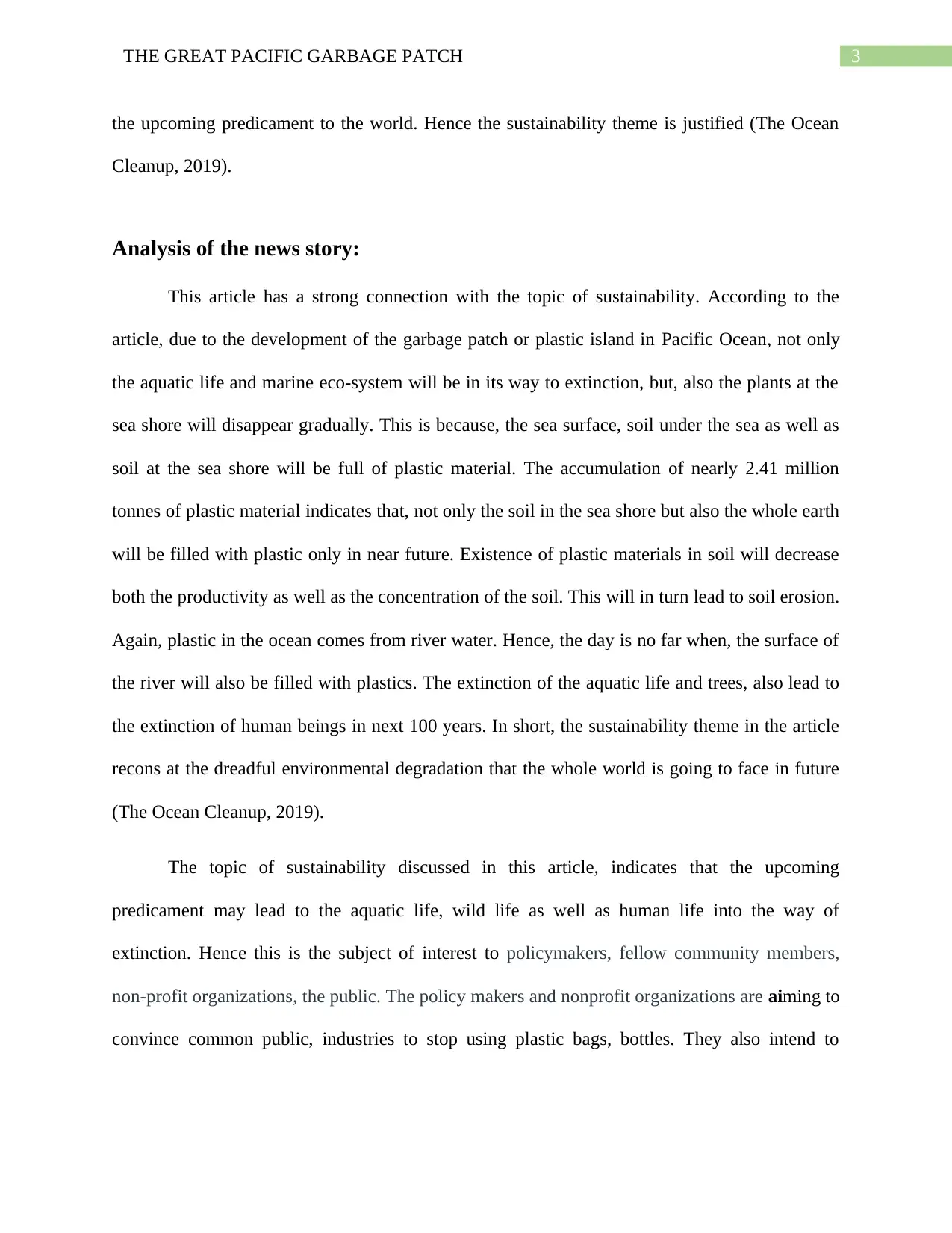
3THE GREAT PACIFIC GARBAGE PATCH
the upcoming predicament to the world. Hence the sustainability theme is justified (The Ocean
Cleanup, 2019).
Analysis of the news story:
This article has a strong connection with the topic of sustainability. According to the
article, due to the development of the garbage patch or plastic island in Pacific Ocean, not only
the aquatic life and marine eco-system will be in its way to extinction, but, also the plants at the
sea shore will disappear gradually. This is because, the sea surface, soil under the sea as well as
soil at the sea shore will be full of plastic material. The accumulation of nearly 2.41 million
tonnes of plastic material indicates that, not only the soil in the sea shore but also the whole earth
will be filled with plastic only in near future. Existence of plastic materials in soil will decrease
both the productivity as well as the concentration of the soil. This will in turn lead to soil erosion.
Again, plastic in the ocean comes from river water. Hence, the day is no far when, the surface of
the river will also be filled with plastics. The extinction of the aquatic life and trees, also lead to
the extinction of human beings in next 100 years. In short, the sustainability theme in the article
recons at the dreadful environmental degradation that the whole world is going to face in future
(The Ocean Cleanup, 2019).
The topic of sustainability discussed in this article, indicates that the upcoming
predicament may lead to the aquatic life, wild life as well as human life into the way of
extinction. Hence this is the subject of interest to policymakers, fellow community members,
non-profit organizations, the public. The policy makers and nonprofit organizations are aiming to
convince common public, industries to stop using plastic bags, bottles. They also intend to
the upcoming predicament to the world. Hence the sustainability theme is justified (The Ocean
Cleanup, 2019).
Analysis of the news story:
This article has a strong connection with the topic of sustainability. According to the
article, due to the development of the garbage patch or plastic island in Pacific Ocean, not only
the aquatic life and marine eco-system will be in its way to extinction, but, also the plants at the
sea shore will disappear gradually. This is because, the sea surface, soil under the sea as well as
soil at the sea shore will be full of plastic material. The accumulation of nearly 2.41 million
tonnes of plastic material indicates that, not only the soil in the sea shore but also the whole earth
will be filled with plastic only in near future. Existence of plastic materials in soil will decrease
both the productivity as well as the concentration of the soil. This will in turn lead to soil erosion.
Again, plastic in the ocean comes from river water. Hence, the day is no far when, the surface of
the river will also be filled with plastics. The extinction of the aquatic life and trees, also lead to
the extinction of human beings in next 100 years. In short, the sustainability theme in the article
recons at the dreadful environmental degradation that the whole world is going to face in future
(The Ocean Cleanup, 2019).
The topic of sustainability discussed in this article, indicates that the upcoming
predicament may lead to the aquatic life, wild life as well as human life into the way of
extinction. Hence this is the subject of interest to policymakers, fellow community members,
non-profit organizations, the public. The policy makers and nonprofit organizations are aiming to
convince common public, industries to stop using plastic bags, bottles. They also intend to
Paraphrase This Document
Need a fresh take? Get an instant paraphrase of this document with our AI Paraphraser
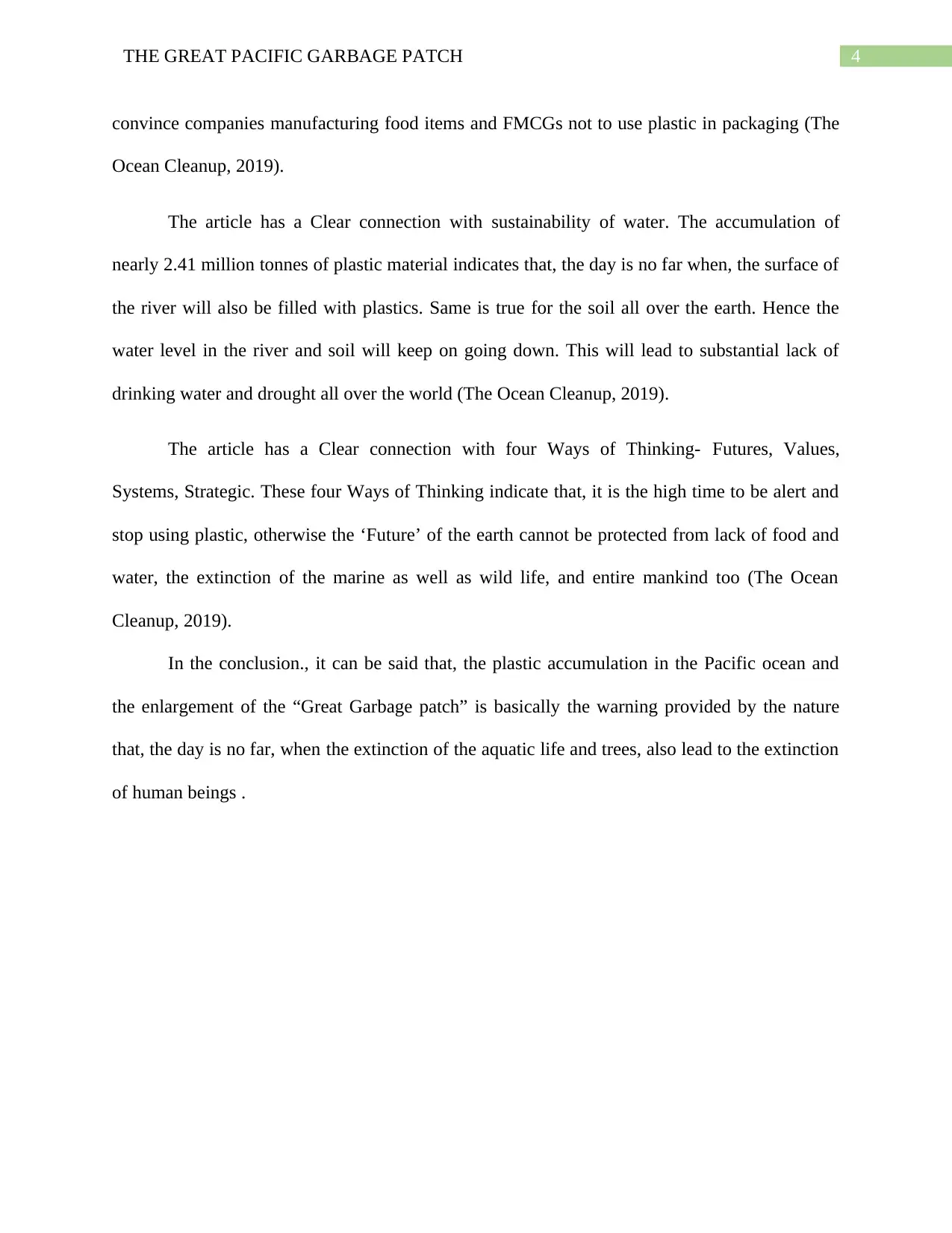
4THE GREAT PACIFIC GARBAGE PATCH
convince companies manufacturing food items and FMCGs not to use plastic in packaging (The
Ocean Cleanup, 2019).
The article has a Clear connection with sustainability of water. The accumulation of
nearly 2.41 million tonnes of plastic material indicates that, the day is no far when, the surface of
the river will also be filled with plastics. Same is true for the soil all over the earth. Hence the
water level in the river and soil will keep on going down. This will lead to substantial lack of
drinking water and drought all over the world (The Ocean Cleanup, 2019).
The article has a Clear connection with four Ways of Thinking- Futures, Values,
Systems, Strategic. These four Ways of Thinking indicate that, it is the high time to be alert and
stop using plastic, otherwise the ‘Future’ of the earth cannot be protected from lack of food and
water, the extinction of the marine as well as wild life, and entire mankind too (The Ocean
Cleanup, 2019).
In the conclusion., it can be said that, the plastic accumulation in the Pacific ocean and
the enlargement of the “Great Garbage patch” is basically the warning provided by the nature
that, the day is no far, when the extinction of the aquatic life and trees, also lead to the extinction
of human beings .
convince companies manufacturing food items and FMCGs not to use plastic in packaging (The
Ocean Cleanup, 2019).
The article has a Clear connection with sustainability of water. The accumulation of
nearly 2.41 million tonnes of plastic material indicates that, the day is no far when, the surface of
the river will also be filled with plastics. Same is true for the soil all over the earth. Hence the
water level in the river and soil will keep on going down. This will lead to substantial lack of
drinking water and drought all over the world (The Ocean Cleanup, 2019).
The article has a Clear connection with four Ways of Thinking- Futures, Values,
Systems, Strategic. These four Ways of Thinking indicate that, it is the high time to be alert and
stop using plastic, otherwise the ‘Future’ of the earth cannot be protected from lack of food and
water, the extinction of the marine as well as wild life, and entire mankind too (The Ocean
Cleanup, 2019).
In the conclusion., it can be said that, the plastic accumulation in the Pacific ocean and
the enlargement of the “Great Garbage patch” is basically the warning provided by the nature
that, the day is no far, when the extinction of the aquatic life and trees, also lead to the extinction
of human beings .
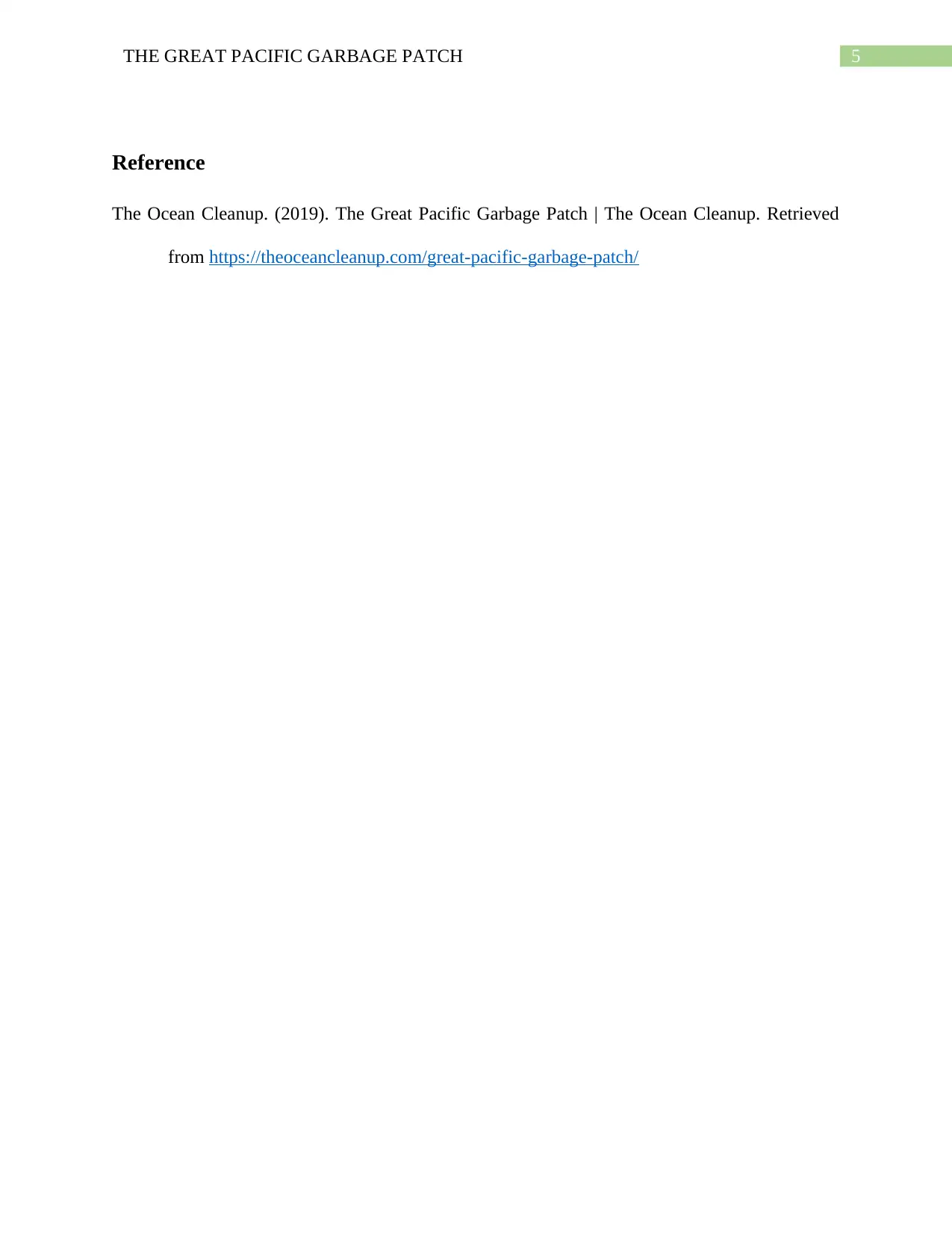
5THE GREAT PACIFIC GARBAGE PATCH
Reference
The Ocean Cleanup. (2019). The Great Pacific Garbage Patch | The Ocean Cleanup. Retrieved
from https://theoceancleanup.com/great-pacific-garbage-patch/
Reference
The Ocean Cleanup. (2019). The Great Pacific Garbage Patch | The Ocean Cleanup. Retrieved
from https://theoceancleanup.com/great-pacific-garbage-patch/
⊘ This is a preview!⊘
Do you want full access?
Subscribe today to unlock all pages.

Trusted by 1+ million students worldwide
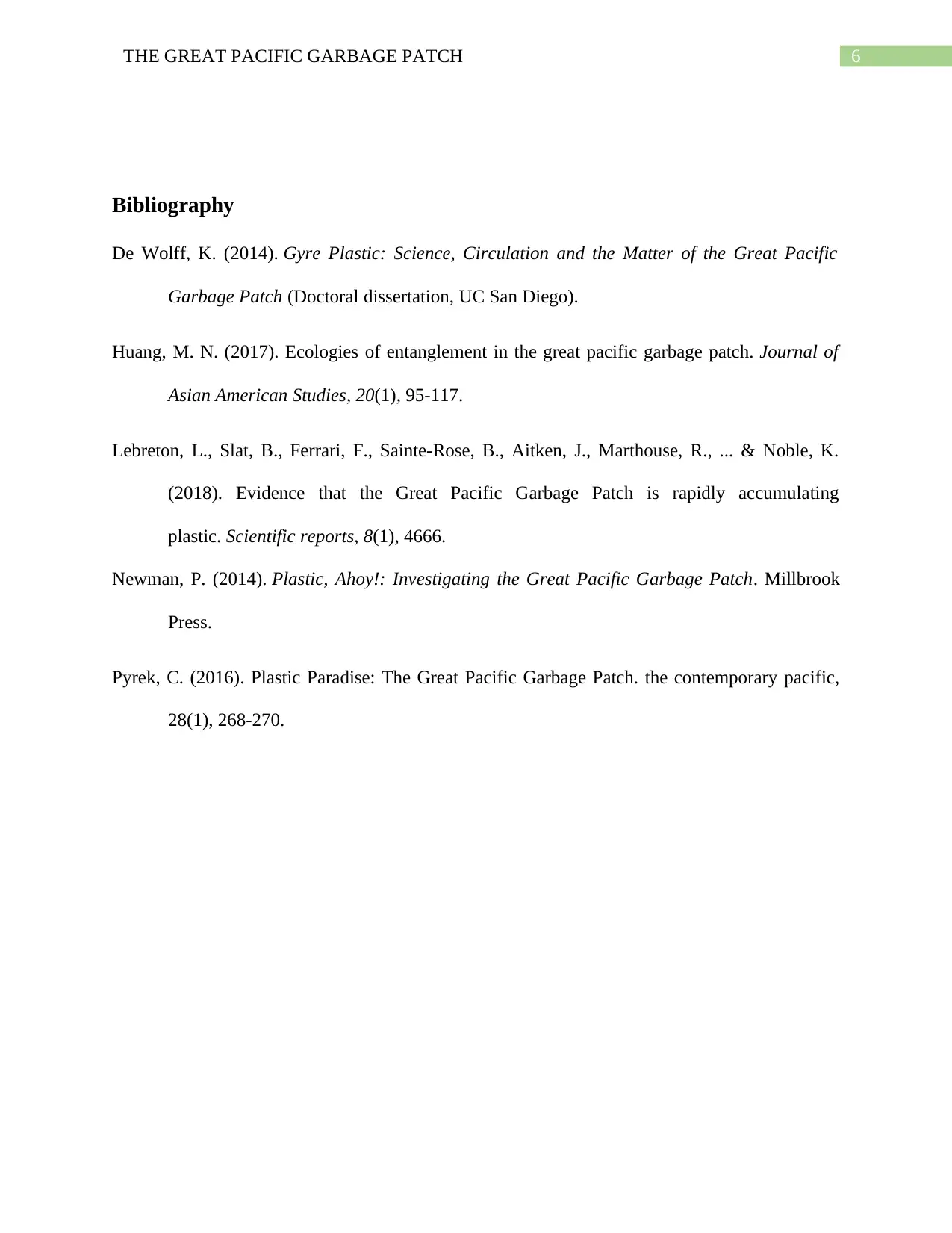
6THE GREAT PACIFIC GARBAGE PATCH
Bibliography
De Wolff, K. (2014). Gyre Plastic: Science, Circulation and the Matter of the Great Pacific
Garbage Patch (Doctoral dissertation, UC San Diego).
Huang, M. N. (2017). Ecologies of entanglement in the great pacific garbage patch. Journal of
Asian American Studies, 20(1), 95-117.
Lebreton, L., Slat, B., Ferrari, F., Sainte-Rose, B., Aitken, J., Marthouse, R., ... & Noble, K.
(2018). Evidence that the Great Pacific Garbage Patch is rapidly accumulating
plastic. Scientific reports, 8(1), 4666.
Newman, P. (2014). Plastic, Ahoy!: Investigating the Great Pacific Garbage Patch. Millbrook
Press.
Pyrek, C. (2016). Plastic Paradise: The Great Pacific Garbage Patch. the contemporary pacific,
28(1), 268-270.
Bibliography
De Wolff, K. (2014). Gyre Plastic: Science, Circulation and the Matter of the Great Pacific
Garbage Patch (Doctoral dissertation, UC San Diego).
Huang, M. N. (2017). Ecologies of entanglement in the great pacific garbage patch. Journal of
Asian American Studies, 20(1), 95-117.
Lebreton, L., Slat, B., Ferrari, F., Sainte-Rose, B., Aitken, J., Marthouse, R., ... & Noble, K.
(2018). Evidence that the Great Pacific Garbage Patch is rapidly accumulating
plastic. Scientific reports, 8(1), 4666.
Newman, P. (2014). Plastic, Ahoy!: Investigating the Great Pacific Garbage Patch. Millbrook
Press.
Pyrek, C. (2016). Plastic Paradise: The Great Pacific Garbage Patch. the contemporary pacific,
28(1), 268-270.
1 out of 7
Your All-in-One AI-Powered Toolkit for Academic Success.
+13062052269
info@desklib.com
Available 24*7 on WhatsApp / Email
![[object Object]](/_next/static/media/star-bottom.7253800d.svg)
Unlock your academic potential
Copyright © 2020–2025 A2Z Services. All Rights Reserved. Developed and managed by ZUCOL.